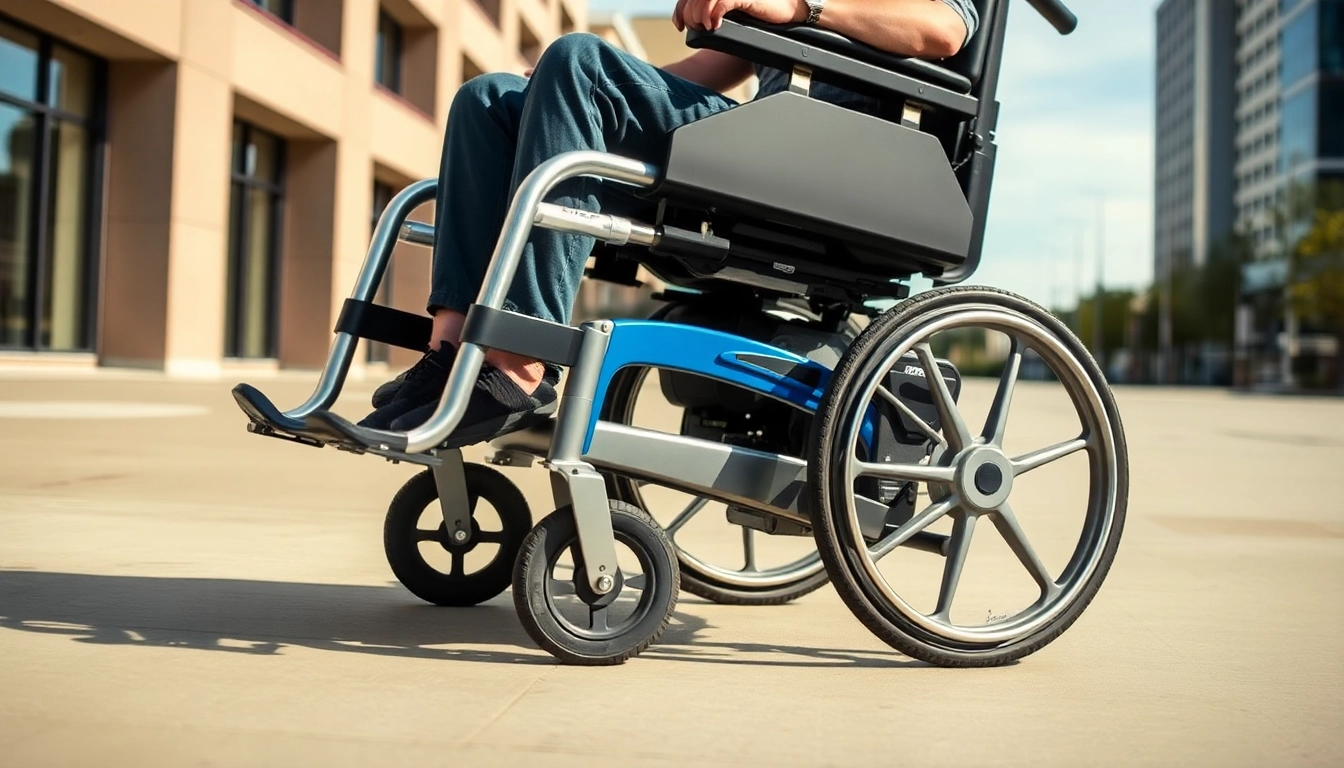Understanding Power Wheelchairs
In today’s world, mobility and independence are crucial for many individuals, particularly for people with disabilities or chronic illnesses affecting their ability to walk. One of the most transformative solutions available is the power wheelchair. These advanced devices not only enhance mobility but also improve the quality of life for users by providing them with the freedom to move without assistance. In this comprehensive guide, we will explore what power wheelchairs are, their key components, benefits, types, and how to choose and maintain one effectively.
What is a Power Wheelchair?
A power wheelchair, also known as an electric wheelchair, is a mobility device powered by batteries, which allows users to navigate their environment without the physical exertion required in a manual wheelchair. By utilizing joystick controls or other driving mechanisms, users can effortlessly steer their chair, making it accessible for those with limited upper body strength or coordination. Power wheelchairs are designed to accommodate various needs, from basic mobility to complex rehabilitation scenarios, and they can be used indoors and outdoors, depending on the model specifications.
Key Components of Power Wheelchairs
A power wheelchair consists of several key components that work seamlessly to provide mobility and comfort:
- Chassis: The base of the wheelchair, which houses the battery and motor.
- Battery: A rechargeable power source that drives the wheelchair.
- Motor: Converts electrical energy from the battery into mechanical energy to move the chair.
- Control System: Joystick or other interfaces allowing the user to control speed and direction.
- Seating System: Ergonomically designed seating for comfort, often adjustable for user needs.
- Wheels: Designed for various terrains; may feature specialized designs for better traction and maneuverability.
- Safety Features: Include seat belts, anti-tip bars, and speed limiters to protect the user.
Benefits of Using a Power Wheelchair
Power wheelchairs offer numerous benefits, significantly enhancing the user’s quality of life. Some key advantages include:
- Improved Mobility: Users can travel greater distances with less effort, gaining independence.
- Enhanced Comfort: Ergonomic design reduces the risk of pressure sores and provides better back support.
- Customizability: Options for different seating positions, controls, and accessories cater to individual needs.
- Safety: Built-in safety features help prevent accidents and injuries.
- Increased Social Interaction: Enables users to participate more easily in social activities and community events.
Types of Power Wheelchairs
When choosing a power wheelchair, it is essential to consider the various types available and their unique features.
Basic vs. Advanced Power Wheelchairs
Power wheelchairs can typically be categorized as basic and advanced models:
- Basic Power Wheelchairs: These models often provide standard functionality with essential features, making them ideal for individuals who require a mobility aid primarily for indoor use or short distances. They generally include a simple control interface and modest speed options.
- Advanced Power Wheelchairs: Equipped with sophisticated features such as customizable seating, enhanced suspension, and a range of advanced controls, these models cater to those needing specialized support for outdoor use or complex mobility challenges. Customers can also explore options with tilt, recline, and standing functions.
Specialized Power Wheelchairs for Specific Needs
Additionally, several specialized power wheelchairs cater to distinct user needs, such as:
- Pediatric Power Wheelchairs: Designed for children, these models often incorporate additional safety features and adjustable settings for growing users.
- Outdoor Power Wheelchairs: Built for rougher terrains, these wheelchairs feature robust tires and reinforced frames for durability.
- Elevating Wheelchairs: These come with mechanisms that allow the user to elevate the seat, ideal for social interactions at eye level or activities like cooking and grooming.
- Sports Wheelchairs: Designed for specific activities, these wheelchairs prioritize speed and agility, often made from lightweight materials.
Comparison of Popular Models
The market for power wheelchairs is vast, with many brands and models. Some of the most popular options include:
- Permobil F5 Corpus: Offers advanced seating options and a powerful drive system, suitable for both indoor and outdoor use.
- Sunrise Medical Quickie Q700: Known for its advanced performance and technology, including customizable seating and driving controls.
- Invacare TDX SP2: This model provides excellent maneuverability and stability, along with a range of customizable seating options.
- Magic Mobility X8: Designed for rough terrains, this wheelchair offers off-road capabilities while maintaining comfort.
Choosing the Right Power Wheelchair
Selecting the right power wheelchair is a crucial decision that can significantly impact an individual’s mobility and quality of life. Various factors must be taken into account to find the best fit.
Key Considerations for Selecting a Power Wheelchair
Several important factors should be evaluated when choosing a power wheelchair:
- Weight Capacity: Ensure that the wheelchair can support the user’s weight comfortably.
- Dimensions: Assess the wheelchair’s dimensions, especially if it will be used indoors, ensuring it can fit through doorways and maneuver in tight spaces.
- Type of Terrain: Consider where the wheelchair will be used most frequently—indoors, outdoors, or both. Different models perform better on varying terrains.
- Controller Type: Explore different control options such as joysticks, sip-and-puff systems, or switches based on the user’s motor capabilities.
- Battery Range: Determine the average distance the user needs to travel on a single charge and choose a model with a sufficient battery range.
How to Fit a Power Wheelchair to Your Body
Proper fitting is pivotal for comfort and functionality. Follow these steps:
- Measure the seat width and depth based on the user’s body dimensions.
- Adjust the armrests to ensure they support the user comfortably without restricting movement.
- Set the footrests to allow the user’s feet to rest flat while maintaining a natural leg position.
- Consider adding custom cushions or supports for additional comfort and prevention of pressure sores.
Assessing Lifestyle Needs and Mobility
Every individual has unique lifestyle needs impacting their choice of power wheelchair:
- Activity Level: If the user is more active and requires outdoor use, consider a robust, all-terrain model.
- Living Environment: Evaluate the home layout—apartment dwellers may require more compact models.
- Social Engagement: Determine how the wheelchair may facilitate or limit social interaction and accessibility.
- Assistive Technology: Consider any additional technology users may need, such as adapted smartphones or environmental controls.
Maintenance Tips for Power Wheelchairs
To ensure longevity and reliability, regular maintenance is essential for power wheelchairs. Proper care can also enhance the user’s experience and safety.
Regular Maintenance Practices
Here are practical maintenance practices to follow:
- Daily Checks: Inspect the wheelchair for any visible wear or loose components before use.
- Cleaning: Regularly clean the chair to remove dust and debris from wheels and seating areas.
- Battery Care: Keep the battery charged as per the manufacturer’s instructions and verify its condition frequently.
- Tire Maintenance: Monitor tire pressure and check for any signs of damage or wear.
Common Repairs and Troubleshooting
Users should familiarize themselves with common issues and potential troubleshooting steps:
- Battery Issues: If the wheelchair is not holding a charge, the battery may need replacement.
- Control Problems: If the joystick is unresponsive, it may need recalibration or checking connections.
- No Power: Troubleshoot the power system by checking the circuit breaker or fuses.
Extending the Life of Your Power Wheelchair
To maximize the lifespan of a power wheelchair:
- Follow Manufacturer Guidelines: Adhere to all maintenance schedules and instructions provided by the manufacturer.
- Store Appropriately: Store the wheelchair in a cool, dry place to prevent damage from moisture or extreme temperatures.
- Professional Servicing: Schedule regular check-ups with a qualified technician to identify and address any potential concerns early.
Real-Life Experiences with Power Wheelchairs
Understanding the impact of power wheelchairs can be better appreciated through real-life experiences shared by users. This section highlights testimonials and case studies, emphasizing the transformative potential of these mobility devices.
User Testimonials and Stories
Here are a few user stories that highlight the positive effects of power wheelchairs:
- Maria’s Story: After acquiring a power wheelchair, Maria regained her independence, allowing her to move around the community and connect with friends.
- John’s Experience: Living with muscular dystrophy, John found that using a power wheelchair enabled him to participate in family outings without requiring constant assistance.
- Linda’s Journey: Linda shared how a custom-modified power wheelchair helped her transition back to work after an accident, improving both her emotional and social life.
Case Studies: Adapting to a Power Wheelchair
Several case studies further illustrate the adjustment process:
- Case Study 1: A 34-year-old man who transitioned to a power wheelchair following a spinal cord injury learned how to independently navigate both his home and workplace.
- Case Study 2: A senior citizen who faced mobility issues adopted a power wheelchair specifically designed for outdoor use, enabling him to reconnect with community landscaping activities.
- Case Study 3: A family utilized a pediatric power wheelchair to enhance their child’s interaction at school, often leading to improved social skills and confidence.
Community and Support Resources
Community resources provide invaluable support for power wheelchair users:
- Online Forums: Websites and social media groups where users share experiences, tips, and troubleshooting advice.
- Local Support Groups: Organizations offering social and emotional support, along with access to modified activities.
- Healthcare Providers: Physical therapists can provide ongoing assessments and recommendations to optimize wheelchair use.
- Mobility Equipment Fairs: Events showcasing the latest wheelchair technology and offering opportunities for users to test various models.



